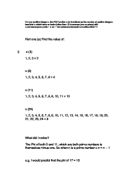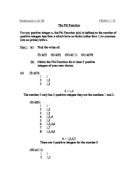The Phi Function Investigation
For any positive integer n, the Phi Function o (n) is defined as the number of positive integers less than n which have no factor (other than 1) in common (are co-prime) with n.xml:namespace prefix = o ns = "urn:schemas-microsoft-com:office:office" />
Part one (a) Find the value of:
I) o (3)
, 2, 3 = 2
o (8)
, 2, 3, 4, 5, 6, 7, 8 = 4
o (11)
, 2, 3, 4, 5, 6, 7, 8, 9, 10, 11 = 10
o (24)
, 2, 3, 4, 5, 6, 7, 8, 9, 10, 11, 12, 13, 14, 15, 16, 17, 18, 19, 20, 21, 22, 23, 24 = 8
What did I notice?
The Phi of both 3 and 11, which are both prime numbers is themselves minus one. So when n is a prime number o n = n - 1
e.g. I would predict that the phi of 17 = 16
o(17)
, 2, 3, 4, 5, 6, 7, 8, 9, 10, 11, 12, 13, 14, 15, 16, 17 = 16
My formula has proved successful.
PART ONE (b)
Obtain the Phi function for at least 5 positive integers of your own choice
i) o(10) I am using 10 as it is an even number....
1, 2, 3 ,4 ,5 ,6 , 7, 8 , 9, 10 = 4
ii) o(17) I am using 17 as it is a prime number....
1, 2, 3 , 4, 5, 6 , 7, 8, 9, 10, 11, 12, 13, 14, 15, 16, 17 = 16
iii) o(15) I am using 15 as it is a odd number....
1, 2, 3 , 4, 5, 6 , 7, 8, 9, 10, 11, 12, 13, 14, 15 = 8
iv) o(16) I am using 16 as it is square number....
1, 2, 3 , 4, 5, 6 , 7, 8, 9, 10, 11, 12, 13, 14, 15, 16 = 8
v) o(27) I am using 27 as it is a cubed number....
, 2, 3, 4, 5, 6, 7, 8, 9, 10, 11, 12, 13, 14, 15, 16, 17, 18, 19, 20, 21, 22, 23, 24, 25, 26, 27 = 18
PART TWO (a)
i) o (7 x 4) = o (7) x o (4)
7 x 4 = 28
...
This is a preview of the whole essay
iv) o(16) I am using 16 as it is square number....
1, 2, 3 , 4, 5, 6 , 7, 8, 9, 10, 11, 12, 13, 14, 15, 16 = 8
v) o(27) I am using 27 as it is a cubed number....
, 2, 3, 4, 5, 6, 7, 8, 9, 10, 11, 12, 13, 14, 15, 16, 17, 18, 19, 20, 21, 22, 23, 24, 25, 26, 27 = 18
PART TWO (a)
i) o (7 x 4) = o (7) x o (4)
7 x 4 = 28
o (28) = 12 o(28) = o (7) x o (4)
o (7) = 6 12 = 6 x 2
o (4) = 2
ii) o (6 x 4) = o (6) x o (4)
o (24) = 8 o(24) = o (6) x o (4)
o (6) = 2 = 2 x 2
o (4) = 2 8 = 4
PART TWO (b)
Check whether or not o (n x m) = o (n) x o (m) for at least two separate choices of n and m....
o(35) I have picked 5 and 7 as they are both prime numbers...
, 2, 3, 4, 5, 6, 7, 8, 9, 10, 11, 12, 13, 14, 15, 16, 17, 18, 19, 20, 21, 22, 23, 24, 25, 26, 27, 28, 29, 30, 31, 32, 34, 35 = 24
o(5) x o(7) = o(35)
o(5) x o(7) = 24
4 x 6 = 24
I would suggest that when both numbers are prime, that
o(n x m) = o(n) x o(m)
PART THREE
o (5) x o (10)
I am using 5 as it is a prime number, and 10 as it is an even number and has 5 as one of it's factors
o(5 x 10) = o (5) x o (10)
o(50) = o(5) = 4 x o(10) = 4
probably dun need
, 2, 3, 4, 5, 6, 7, 8, 9, 10, 11, 12, 13, 14, 15, 16, 17, 18, 19, 20, 21, 22, 23, 24, 25, 26, 27, 28, 29, 30, 31, 32, 34, 35, 36, 37, 38, 39, 40, 41, 42, 43, 44, 45, 46, 47, 48, 49, 50 = 20
20 = 8
o (4) x o (8) = o ( 4 x 8 )
I am using 4 and 8 as they are two even numbers and one is half of the other...
, 2, 3, 4, 5, 6, 7, 8, 9, 10, 11, 12, 13, 14, 15, 16, 17, 18, 19, 20, 21, 22, 23, 24, 25, 26, 27, 28, 29, 30, 31, 32 = 16
o(32) = 16
o(8) = 4
o(4) = 2
4 x 2 = 16
So when I use two even numbers, or when I use a prime and an even number (which has the prime number as it's factor) the equation
o (n x m) = o(n) x o(m) doesn't work.
Now I will try using 3 sets of a Prime number and a Squared number...
o(11) x o(16) = o( 11 x 16 )
o(11) = 10 o(11 x 16) = 176
o(16) = 8 o(176) = 80
o(11) x o(16) = o(176) = 80
o(11) x o(16) = o( 11 x 16 )
o(7) x o(9) = o( 7 x 9)
o(7) = 6 o( 7 x 9) = o63
o(9) = 6 o(63) = 36
6 x 6 = 36
o(7) x o(9) = o( 7 x 9)
All of my equations worked...therefore I can conclude that o (n x m) = o(n) x o(m) where n is a prime number and m is any number at all.
PART FOUR
Now I intend to investigate a prime number to any power.
I will now find o(2 ), o(3 ) and o(5 ).
o(2 ) = 2 o(3 ) = 6 o(5 ) = 20
It appears at though the o function of any number squared is that number times one less than it. I will now try to find where this answer of 20 comes from:
o(5 ) = o(25) therefore 5 x 4 = 20
o25 = [1, 2, 3, 4] 5 [6, 7, 8, 9] 10[11, 12, 13, 14] 15 [16, 17, 18, 19] 20 [21, 22, 23, 24] 25 = 20
I can see that the answer of 20 comes from five groups of four numbers (as I have shown above). I will check this idea by repeating my method of working out for 6 . I would predict that the o function of 36 is 6 x 5 which equals 30 because all the multiples of 6 up to 36 will be removed, leaving 6 groups or 5 numbers.
[1, 2, 3, 4, 5] 6 [7, 8, 9, 10, 11] 12 [13, 14, 15, 16, 17] 18 [19, 20, 21, 22, 23] 24[25, 26, 27, 28, 29] 30 [31, 32, 34, 35] 36
My prediction is shown as correct, so I can state that: o(n ) = n ( n - 1 )
Where n is a prime number.
I am now going investigate a prime number to any power. Starting with the easiest, 2 .
2 = 8 This number 4 looks like having come from 8-4
o(8) = 4
3 = 27
o(27) = 18
[1, 2] 3[4, 5] 6[7, 8] 9[10, 11] 12 [13 14] 15 [16, 17] 18 [19, 20] 21 [22, 23] 24 [25, 26] 27
This Number 18 looks like it's coming from 27 - 9
There are 9 groups of 2, or I have removed 9 numbers from a total of 27 giving me out an answer of 18.
o(27) = 27 - 9 = 18
o(8) = 8 - 4 = 4
I can note a relationship developing, 27 being 3 , and 9 being 3 . Just as 8 being 2 , 4 is 2 .
Now I can test this theory on 4 .
I can predict that for 4 , because it equals 64, that the function will equal 4 - 4
o64 = 64 - 16 = 48
This equation is wrong, as the o function of 64 is not 48, from this I can conclude that the theory of the relationship only works on prime factors.
With this information in mind, I can predict for 5 , that the answer will be 5 - 5 .
So for any number (n) to the power of 3 the answer would be n3 - n2.
I can now apply this knowledge to predict an equation.
For any prime number, to any power.
2 = 16 o16 = 1, 2, 3, 4, 5, 6, 7, 8, 9, 10, 11, 12, 13, 14, 15, 16 = 8
6 - 8 = 8
2 - 2
3 = 81
81 - 27 =
3 - 3
In words, the function of any prime number (p) to any power (n) will be:
p x p







